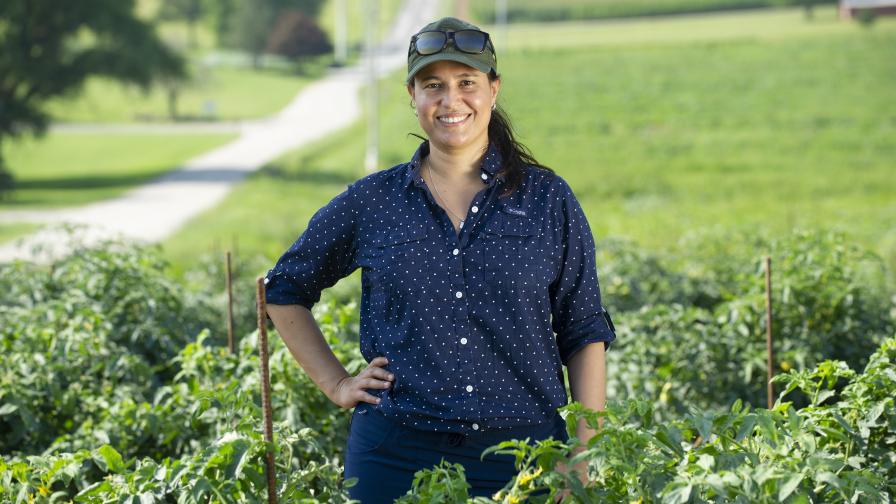To the Water Wise: On-Farm Recharge a Solution for Nut Growers

An on-farm recharge (OFR) results in the intentional flooding of a lot on a pecan farm.
Photo by Sandra Bachand
On-farm recharge (OFR) and the lowered soil oxygen levels that result from the practice do not negatively affect the health and yield of pecans, according to research conducted by a California-based environmental engineering firm.
Bachand & Associates, in collaboration with a grower with Pacific Gold Agriculture, applied 40 feet of water to the grower’s 5.4-acre pecan plot in McFarland, CA, during a 46-day period in 2020 (early May to mid-June). This was the second of two consecutive summers of the pilot study.
Although oxygen levels expectedly dropped to low levels during both years, no negative impacts were reported. The research also identified best practices specific to OFR and siting that can shorten the duration of low oxygen.
“We’re focused on oxygen conditions because I think that’s what people are concerned about,” Sandra Bachand, cofounder of the firm, said in a webinar hosted by the McMullin Area Groundwater Sustainability Agency. “The conclusion is that we didn’t see any effect on the health of these trees because of all this water.”
‘NEW’ WATER
On-farm recharge is a method in which growers flood farmlands during wet years when extra surface water is available to recharge and store the water in underlying aquifers for future use. Bachand’s previous research had shown that flooding a limited area leads to improved groundwater quality over time. Thus, the practice should be conducted on the same fields each year as needed to infiltrate available water.
Pecans comprise approximately 5,000 acres in 17 counties across the Central Valley of California. The study focused on that nut because of its ability to tolerate saturated soils and flooding past dormancy. However, the study results are transferable to other orchard systems, Bachand said.
The motivation behind the project stems from three factors, she added: 1) climate change; 2) California’s Sustainable Groundwater Management Act (SGMA); and 3) the “new” water that OFR offers to help augment groundwater.
“There won’t be as much water available to farming, and that could actually result in less farming acreage — unless we find somehow a new source of water,” Bachand said. “Hopefully we can capture water that would ordinarily just leave the area in a wet year because it can’t be stored by the reservoirs.”
STUDY RESULTS
The project involved four types of treatment: continuous flooding, alternating flooding between subplots, over-irrigation, and regular irrigation. The grower’s existing concrete pipe, after being deemed inadequate by itself, was connected to a poly pipe system to deliver flooding water over the orchard’s Wasco sandy loam soil. Also installed were terraces to maintain more consistent water depths across the field, and silt fences and poly pipe dams to slow water flow and increase water levels and wetted area.
In 2020 the continuously flooded plot received a total of 40.7 feet of water, with 39.8 feet of water going to recharge. As expected, this caused an immediate decline in oxygen at a soil depth of 1 foot. But how far and at what rate did the oxygen level fall? Likewise, how fast did the oxygen recover once the water was turned off?
For fruit and nut trees, an oxygen level of more than 10 kilopascals (kPa) is considered optimal while anything less than 5 kPa is potentially compromising, Bachand said. Oxygen in the soil began at 21 kPa, the regular figure at sea level.
With the continuously flooded plot averaging a drop rate of 1 to 1.5 kPa per day, it would take about seven to 11 days to drop to a level — 10 kPa — that might be harmful, Bachand said. “It’s pretty quick, especially at 1 foot, that you start seeing a change in water content and oxygen level,” she said.
When the water was taken off the field, the oxygen recovered nearly as fast — 1 to 2 kPa per day while the level was below 10 kPa, and 0.2 to 0.8 kPa once it increased to 13 kPa. “So, if you were at 5, it would take about two-and-a-half days to five days to get back up to 10,” Bachand said.
The lowest oxygen level recorded during the OFR study was 0.5 kPa. The level remained below 10 kPa for 15 days in year one of the trial and 24 days in year two. Nonetheless, the pecan trees fared well, Bachand said, in terms of visual assessment, leaf nutrient analyses, stem water potential, and yield.
Also beneficial was OFR’s ability to flush salt from the root zone and its accounting for less irrigation following OFR. “Not only are you doing an on-farm recharge, but we’re also doing an in-lieu recharge,” Bachand said.
Growers can attempt to maintain higher levels of oxygen during OFR by: 1) conducting OFR in fields underlain by highly permeable soil that extends below the root zone; 2) applying water rapidly for several days, allowing the orchard to dry briefly, and then repeating; and 3) applying OFR to every other row and then switching.
“Levels were generally a little bit higher in the alternating row treatment,” Bachand said. “I think that oxygen is entering these systems from below, the side, and not just from above when you have that drier area next to you that is providing a source of oxygen.”










